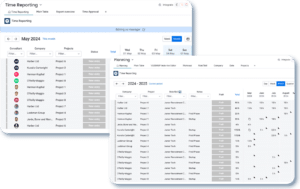Introduction
Why Automation is No Longer Optional
In today’s rapidly evolving business landscape, automation is less of a luxury and more of a necessity. From manufacturing floors to virtual conference rooms, automation technologies are revolutionizing how tasks and processes are executed. While this brings a plethora of advantages—increased efficiency, cost reduction, and heightened competitive edge to name a few—it often meets with resistance from employees and stakeholders. This pushback can range from mild hesitation to outright opposition, posing a significant obstacle to progress. The journey towards automating business operations isn’t merely a technical endeavour; it’s a human one as well. Herein lies the challenge and the focus of our discussion: Overcoming resistance to change during automation implementation. This resistance can emanate from various quarters—be it the boardroom or the break room—and can lead to project delays, financial losses, and even failure if not adequately managed.
The Thesis: Overcoming Resistance is Crucial for Success
Confronting and mitigating this resistance is not just advisable; it is essential for the long-term success and adoption of automation initiatives within an organization. Ignoring these human factors is akin to setting sail in turbulent waters without a compass. The purpose of this blog post is to guide you through the labyrinth of human psychology, organizational politics, and effective management strategies to ensure your automation projects don’t just launch but thrive.
The Need for Automation
Business Efficiency: Doing More With Less
One of the most compelling reasons for adopting automation is the remarkable boost it gives to business efficiency. Tasks that previously took hours can now be accomplished in a fraction of the time. But efficiency is not just about speed; it’s also about doing things right. Automated systems reduce the risk of human error, ensuring that tasks are performed consistently and accurately. Overcoming resistance to change during automation implementation becomes critical when you consider that efficiency gains are not just incremental; they are often exponential.
Cost-Reduction: A Bottom-Line Boost
Automation allows businesses to perform the same operations with fewer resources, thus significantly reducing overhead costs. Whether it’s automating customer service through chatbots or streamlining your inventory management, the cost benefits are substantial. However, these economic advantages can only be fully realized if the human element—resistance to change—is managed effectively during the automation implementation process.
Competitive Advantage: Staying Ahead of the Curve
In the modern business landscape, standing still is the fastest way to fall behind. Automation grants companies the agility and responsiveness they need to stay competitive. From predictive analytics to automated marketing strategies, companies that embrace automation are often the ones leading the pack. Hence, tackling resistance to change is not just beneficial but crucial for maintaining a competitive edge.
Data Accuracy: Minimizing Human Error
In our data-driven world, the accuracy of information is paramount. Automation eliminates the risk of human error in data collection and analysis, which is vital for informed decision-making. But the path to such a data-centric approach is fraught with challenges, the most notable of which is resistance to change. Ensuring smooth automation implementation means preparing your team for new ways of thinking about and utilizing data.
Industry-Specific Examples: From Sales to HR
Automation is not confined to a particular sector; its applications are broad and varied. Whether it’s automated lead generation in sales, data analytics in marketing, project management tools, or even HR software for employee onboarding—every department stands to gain from automation. This universal applicability further amplifies the need for overcoming resistance to change during automation implementation across diverse departments and sectors.
Omnitas Newsletter
Sign up for our monthly newsletter to stay up-to-date on our latest blog articles, videos and events!
Thank you!
You have successfully joined our subscriber list.
Understanding Resistance to Change
The Psychological Factors: Why Do We Resist?
Change, even when beneficial, often triggers a psychological response that can manifest as resistance. At the heart of this reaction are factors such as uncertainty, loss of control, and fear of the unknown. Understanding these underlying motivations is the first step in overcoming resistance to change during automation implementation. By acknowledging these emotional responses, organizations can tailor their implementation strategies to be more empathetic and effective.
Organizational Culture: A Breeding Ground for Resistance
The culture within an organization can significantly influence how change is perceived and received. Companies with a culture that fosters innovation and continuous improvement are generally more open to the idea of automation. On the other hand, organizations that value traditional methods and long-standing processes may find greater resistance among their workforce. Therefore, understanding and potentially adapting the organizational culture is crucial for a smooth automation transition.
Fear of Job Loss: The Elephant in the Room
One of the most common fears associated with automation is the perception that machines will replace human jobs. While automation does reshape the job landscape, it often leads to the creation of new roles and opportunities. Addressing this fear directly and transparently is vital for overcoming resistance to change during automation implementation.
Fear of Incompetence: Can I Adapt?
Another frequent concern is the fear of incompetence or the feeling that one will not be able to adapt to the new systems and technologies. This fear can be debilitating and may lead to active resistance against automation initiatives. Providing training and development opportunities can alleviate these concerns and facilitate a more receptive attitude towards change.
Historical Failures: The Ghosts of Projects Past
Past failures in implementing new systems or methodologies can haunt current automation efforts. Employees may be sceptical about the likelihood of success based on previous experiences. In such cases, it’s essential to address these past failures explicitly, outlining what has changed and why this time will be different.
The Consequences of Not Addressing Resistance
Project Failure or Delays: Lost Time and Opportunities
Ignoring or underestimating the resistance to automation can lead to project delays or, in extreme cases, complete failure. When employees are not on board with changes, it impacts the timeline and the quality of implementation. This not only results in lost time but also lost opportunities to gain competitive advantages, underscoring the importance of overcoming resistance to change during automation implementation.
Financial Losses: The Hidden Costs of Resistance
Resistance has a real financial impact. The costs can manifest in different ways—productivity losses, poor quality of work, and increased time and resources spent on managing the fallout. These financial setbacks can quickly escalate and severely impact the organization’s bottom line, emphasizing the economic imperative of managing resistance during automation processes.
Decline in Employee Morale: A Vicious Cycle
When employees resist change, their job satisfaction and morale often decline, which can create a vicious cycle. A workforce that is dissatisfied and disengaged is less likely to adopt new systems willingly, resulting in further resistance and jeopardizing the automation initiative. Hence, understanding and overcoming resistance to change during automation implementation isn’t just a managerial challenge but a human one that affects the entire organizational ecosystem.
Inefficiency and Lost Opportunities: The Long-Term Impact
The goal of automation is to make processes more efficient, but resistance can create a bottleneck that defeats this purpose. Not addressing this resistance means your organization could be stuck with outdated systems and processes, missing out on the countless benefits that automation brings.
Identifying the Root Causes of Resistance
The Managerial Approach: More Than Just a Technical Problem
Understanding that resistance to change is not just a technical issue but a managerial one is key. Organizations must go beyond merely installing new software or hardware; they must address the human elements that are integral to the system’s success. Therefore, identifying the root causes is an essential managerial task in overcoming resistance to change during automation implementation.
Tools and Methods: How to Unearth the Underlying Issues
Various tools can assist in identifying the sources of resistance. These can range from informal methods like observations and casual discussions to more structured approaches like surveys and interviews.
Surveys: The Quantitative Measure
Employee surveys can be an effective way to gauge general sentiments about upcoming changes. These surveys can be anonymous to encourage candid responses, providing invaluable data that can guide implementation strategies.
Interviews: The Qualitative Insight
One-on-one interviews offer deeper insights into the concerns and hesitations of employees. These sessions can unveil specific issues that may not be apparent in broader surveys, allowing for more targeted interventions.
Observations: The Unspoken Clues
Sometimes, resistance manifests not in what employees say but in what they do. Observation can reveal patterns of behaviour that signal resistance, such as decreased productivity or increased absenteeism.
Leveraging Data: Turning Information Into Action
Once the root causes are identified, the next step is leveraging this information to tailor your change management strategies. Knowing precisely what obstacles you’re up against allows for a more focused and effective approach, thereby increasing the odds of successfully overcoming resistance to change during automation implementation.

Strategies for Overcoming Resistance to Change
Transparent Communication: Setting the Stage for Success
Open, honest, and timely communication is essential when introducing any organizational change, but it’s especially critical for overcoming resistance to change during automation implementation. Providing comprehensive information about the what, why, and how of the automation process can go a long way in alleviating fears and misconceptions.
Town Halls and Webinars
Regularly scheduled town hall meetings or webinars can serve as a platform for discussing upcoming changes, addressing concerns, and providing updates. These settings allow for two-way communication, making employees feel heard and involved.
Newsletters and Updates
Regularly disseminated newsletters or email updates can keep the staff informed about the automation project’s progress, reinforcing the importance and benefits of the changes.
Training and Development: Equipping for Change
The fear of incompetence is a significant source of resistance. Offering training and development opportunities can help staff feel more comfortable and competent in using the new automated systems.
Workshops and Seminars
On-site or virtual workshops can provide hands-on experience, giving employees the chance to familiarize themselves with new tools and processes.
Continuous Learning Resources
Providing a repository of learning materials, such as video tutorials and FAQs, can offer ongoing support, helping employees overcome challenges as they adapt to new systems.
Employee Involvement: The Power of Participation
Involving employees in the automation process can transform them from passive recipients of change to active contributors, thus mitigating resistance.
Focus Groups and Feedback Loops
Creating focus groups or feedback loops can facilitate a deeper understanding of employee concerns, which can be invaluable for refining implementation strategies.
Incentives and Rewards: Motivating Adoption
Sometimes, a little positive reinforcement can go a long way. Offering incentives and rewards for quick adaptation to new systems can encourage employees to embrace change more readily.
Best Practices in Consultation for Automation Implementation
Leveraging Expertise: Why Consultation Matters
When it comes to automation implementation, the road to success is rarely a solitary one. Leveraging external expertise through consultation can provide valuable insights, specialized knowledge, and a fresh perspective on overcoming resistance to change during automation implementation.
The Consultation Process: A Structured Approach
Consultation in this context goes beyond mere advice-giving. It’s a structured process that involves various steps, each aimed at maximizing the chances of successful implementation and minimizing resistance.
Gap Analysis
Consultants often start with a gap analysis to assess the difference between current operations and the desired state post-automation. This analysis is crucial for identifying areas where resistance is likely to occur and for tailoring strategies to overcome it.
Stakeholder Identification
Identifying key stakeholders early in the process can provide a clearer picture of where potential resistance might arise. Engaging these stakeholders can lead to valuable insights and stronger buy-in for the project.
Customized Training Plans
A one-size-fits-all approach rarely works when it comes to training for new systems. Consultants can help develop customized training plans based on different roles, departments, or skill levels, ensuring everyone is well-prepared to adapt to the new changes.
Risk Mitigation: Preparing for the Unexpected
In any project, unexpected challenges are bound to arise. Effective consultation involves not just planning for known variables but also mitigating risks associated with unknown factors. Proactive risk mitigation can be pivotal in overcoming resistance to change during automation implementation.
Continuous Improvement: Beyond the Implementation Phase
The role of a consultant doesn’t necessarily end once the system goes live. The principle of continuous improvement dictates that systems and processes should be continually assessed and refined. Consultants can provide post-implementation reviews and recommendations, ensuring that any lingering resistance is addressed and that the organization continues to reap the full benefits of automation.
Conclusion
Overcoming resistance to change during automation implementation is a multi-faceted challenge that requires a balanced approach. From understanding the psychological and organizational factors that contribute to resistance, to implementing robust strategies and consulting best practices, there’s a lot that goes into making an automation project successful. The stakes are high, but so are the rewards. Automation doesn’t just replace manual tasks; it opens up avenues for innovation, productivity, and strategic growth.
In today’s rapidly evolving business landscape, organizations cannot afford to let resistance derail their automation efforts. By applying these insights and strategies, you’ll be better positioned to navigate the complexities of change management and lead your team toward a more efficient and productive future.
If you found this article interesting and would like to stay updated on similar content, consider signing up for our monthly newsletter. Whether you’re just curious about automation or are actively seeking solutions, our newsletter provides valuable insights right in your inbox.
Ready to start your own automation journey but need some expert guidance to kick things off? We specialize in helping organizations implement automation successfully, reducing friction and resistance along the way. Book an intro call with us to find out how we can assist you in transforming your business through automation.
























